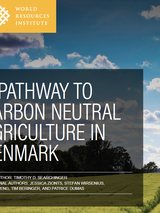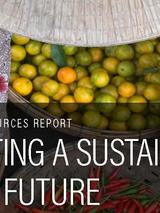Working Papers
Abstract
After agriculture, wood harvest is the human activity that has most reduced the storage of carbon in vegetation and soils1,2. Although felled wood releases carbon to the atmosphere in various steps, the fact that growing trees absorb carbon has led to different carbon-accounting approaches for wood use, producing widely varying estimates of carbon costs. Many approaches give the impression of low, zero or even negative greenhouse gas emissions from wood harvests because, in different ways, they offset carbon losses from new harvests with carbon sequestration from growth of broad forest areas3,4. Attributing this sequestration to new harvests is inappropriate because this other forest growth would occur regardless of new harvests and typically results from agricultural abandonment, recovery from previous harvests and climate change itself. Nevertheless some papers count gross emissions annually, which assigns no value to the capacity of newly harvested forests to regrow and approach the carbon stocks of unharvested forests. Here we present results of a new model that uses time discounting to estimate the present and future carbon costs of global wood harvests under different scenarios. We find that forest harvests between 2010 and 2050 will probably have annualized carbon costs of 3.5–4.2 Gt CO2e yr−1, which approach common estimates of annual emissions from land-use change due to agricultural expansion. Our study suggests an underappreciated option to address climate change by reducing these costs.
2023
Abstract
The world faces a global land squeeze as the world population grows to 10 billion by 2050. Human demands for food, wood products, and urban uses will expand as the population grows and incomes rise. These demands will lead to more conversion of native habitats to agricultural and urban uses; in addition, more natural forests will be converted to wood plantations and increasing amounts of wood will be harvested from relatively natural forests. This growing demand for land-based products will compete with the ability of the remaining native habitats to store carbon and support biodiversity.
2022
2021

2020
2019

Abstract
The full, 566 page report, Creating a Sustainable Food Future: A Menu of Solutions to Feed Nearly 10 Billion People by 2050 is now available. The report, of which I was lead author, explores how to meet food needs in 2050 while protecting ecosystems and reducing agricultural greenhouse gas emisisons to acceptable levels, and in ways that could help to reduce poverty and not exacerbate water challenges. The report was prepared by the World Resources Institute in collaboration with the World Bank, UN Environment, the UN Development Programme, and with technical contributions from INRA and CIRAD.
Some articles about the synthesis of the report appear in the New York Times, the Guardian, and Forbes.
2018
Abstract
Abstract
The European Commission has agreed to a renewable energy directive (RED), which will require that all countries in the European Union increase the percentage of energy that comes from renewable energy by 2030. Although this general regulation is admirable, it treats nearly all bioenergy as fully qualifying, low-carbon, renewable bioenergy including the harvest of wood from forests deliberately to burn.
In January 2018, roughly 800 scientists wrote to the European Parliament warning them that doing so would likely lead to forms of bioenergy that actually increased carbon in the atmosphere for decades compared even to using fossil fuels. This letter along with a video about the issue and other materials can be found at www.empowerplants.com. The letter encouraged the Parliament to limit this qualifying renewable energy from forest biomass to residues and wastes, but the Parliament rejected such an amendment. Eventually, negotiations with the European Commission and Council of States led to an agreed RED that also allows cutting down and burning of whole trees.
This article provides an academic treatment of this issue and finds that the RED could plausibly lead Europe to burn an additional amount of wood equal to all its present wood harvest and increase greenhouse gas emissions from energy use by 10% compared to the alternative. It discusses why the so-called sustainability criteria do not prevent this result.
Abstract
2017
2016
2015
Abstract
For many years, governments and researchers have debated whether corn and wheat ethanol reduce greenhouse gas emissions when counting the emissions from land use change needed to replace the food, and the debates have relied on different global agriculture and land use models. Ultimately, the U.S. Environmental Protection Agency and the California Air Resources Board found that these ethanols did generate modestly fewer emissions than gasoline, relying on different models. The European Commission also commissioned a model that found lower emissions. Meanwhile, many supporters of biofuels argue that because all these models differ in their results, impacts on both greenhouse gases and food are too uncertain to reflect in policies.
In this paper, we analyzed the model results carefully and found that they estimate lower emissions for ethanol because they estimate that from 20-50% of the calories in food are not replaced. Physically, the emissions result from reduced respiration of carbon dioxide (and wastes) by people and livestock. The models attribute these "savings" to the biofuels. And if these estimates were wrong, the models would estimate higher greenhouse gas emissions. The paper therefore highlights that much of the debate between models is which adverse effects predominate not whether these ethanols generate adverse effects.
Those without subscriptions to the journal can gain free access to the paper through these links.
Summary: http://www.sciencemag.org/cgi/content/summary/347/6229/1420?ijkey=3HDvP4VYvLiK2&keytype=ref&siteid=sci
Reprint: http://www.sciencemag.org/cgi/rapidpdf/347/6229/1420?ijkey=3HDvP4VYvLiK2&keytype=ref&siteid=sci
Full Text: http://www.sciencemag.org/cgi/content/full/347/6229/1420?ijkey=3HDvP4VYvLiK2&keytype=ref&siteid=sci

